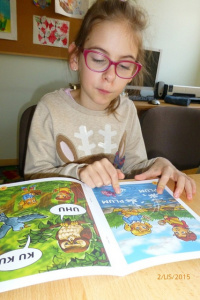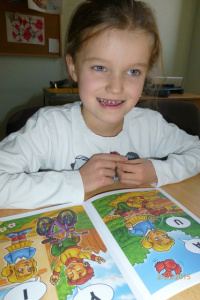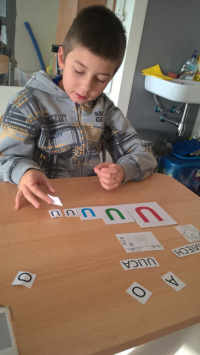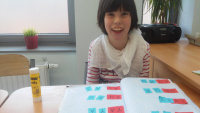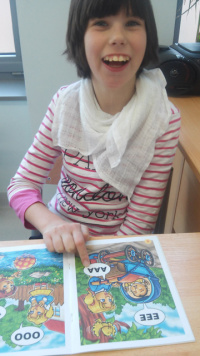Professor Jagoda Cieszyńska's simultaneous and sequential method of learning to read is based on the latest neuropsychological research and many years of author's experience, both therapeutic and speech therapy. Learning to read takes the form of a game in which it is based on the natural activity of the child, using his interests and desire to explore the world. The simultaneous – sequential method of learning to read consists in learning global reading of syllables (sounds are introduced in syllables – never in isolation). The author gives them meaning and, as she emphasizes, it facilitates the child's process of remembering the material and speeds up learning to read (e.g. a picture of dancing children saying "LA, LA, LA" or a picture of an owl sitting on a tree and making a sound "UHU"). Thanks to such comprehensive stimulation, the child has the opportunity to quickly master learning to read with comprehension and improve the overall development of the language. Professor Cieszyńska based her method on knowledge of the human brain. The cerebral hemispheres perform various functions (simultaneous – right hemisphere and sequential – left hemisphere). All tasks based on the work of the right hemisphere (global recognition of heard and read nouns in the nominative nominative, distinguishing similar letters and words, recognizing stimuli containing an emotional charge) are to help the child move to analytical-sequential, left-brain reading as soon as possible.
The author created a series of textbooks "I Love to Read" especially for parents
and teachers who want to take care of their children's future. She developed a package of 18 issues,
in which she included exercises, appropriate for each of the five distinguished stages of learning to read.
Stage I – From primary vowels to open syllable
Learning to read should start with learning oral vowels (mainly the right hemisphere of the brain is involved, which is responsible, m.in for the graphic image of letters). Visualization allows you to integrate in the child's brain an image, sound and movement directly related to a given vowel (e.g. image of the letter "Y", making a sound, raising hands up, imitating the image of letters). After the child has mastered the vowels, open syllables are introduced (e.g. sound-imitating words "MU", "KU KU", etc.). At the first stage, new consonants are successively introduced (always in syllables, never in isolation).
Stage II – From the open syllable to the first words
At the second stage, the range of open syllables is expanded by using new consonants. The teacher also uses sets: vowel + open syllable (eg."ANA", "ENE"). He uses global words already known to the child and introduces new ones – built from newly learned syllables.
Stage III – Reading closed syllables
At the third stage, the teacher works with the child on open and closed syllables with previously learned consonants: P, M, B, L, T, D, F, W, S, Z, K, G, J, N. Closed syllables are introduced, e.g. "LOL", "NYK", "MUK", etc. The student practices reading m.in on pseudo-words, e.g. "ASOS", "KITUME", which are abstract in nature and prevent the child from guessing.
Stage IV – Reading new open and closed syllables
At the fourth stage, the student gets acquainted with digraphs and the consonant "Ł" (which are still realized in closed or open syllables). The number of words read globally and texts is also increased.
Stage V – Independent reading of texts
At the fifth stage, the student independently reads the texts, while working on the syllable material. He continues to practice reading open and closed syllables, this time introducing soft consonants and nasal vowels.
Exercises at each of the five stages of learning to read are carried out according to the rule: repetition – understanding – naming.
Repetition – the teacher reads the sounds and the student repeats, pay attention to the child's mouth when pronouncing individual vowels (which facilitates the process of memorization) and use motor visualization (e.g. a finger on the nose depicting a dot over the "I").
Comprehension (differentiation) – the teacher indicates a vowel and the student reads it, or vice versa – the teacher pronounces the vowel and the student indicates it. If the child has difficulty recognizing the letter, the therapist can prompt him using motor visualization or exposing the mouth arrangement – let the child come to the solution on his own.
Naming (reading) – roles are changed: once the student teaches the teacher, and once the student's teacher, e.g. the child reads the vowels or names the situations depicted in the illustrations, while the adult indicates the appropriate letter (J. Cieszyńska 2012).

